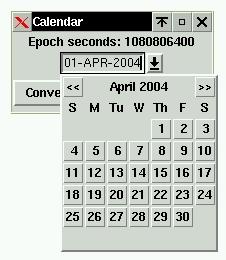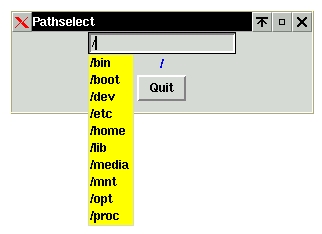Simplified data entry: Tk::DateEntry and Tk::PathEntry
The Tk::DateEntry and the Tk::PathEntry widgets simplify the input of
structured data (namely dates and file paths, respectively), by
providing a display of valid input and allowing the user to
select from them.
The DateEntry widget displays a text
input field with an adjacent button. Clicking the button
displays a calendar in a drop down menu, and selecting a date using
the mouse enters the corresponding string into the text input
field.
Figure 3. The DateEntry widget
Listing 3 shows the code associated with this example. Selecting
Convert calculates the number of
seconds since the beginning of the Unix epoch and displays them
in the Label widget atop the text
input field.
|
Date input is hard because there are so many ways to represent
the same date in string form. The DateEntry provides three standard date
formats (MM/DD/YYYY, YYYY/MM/DD, and DD/MM/YYYY), which can be
selected using the -dateformat
option. If a different date format is desired, the programmer
has to provide the conversion routines explicitly, using the
callbacks -parsecmd and -formatcmd. In the example above, we use a
custom date format, displaying months using 3-letter
acronyms. When parsing the input string into its numerical
constituents, we use the hash %idx_for_mon, which holds the numerical
index of each month (1..12) given its acronym. When a user
selects a date from the drop down menu, it has to be formatted
into the corresponding string, requiring the opposite lookup,
namely the acronym given the index. We build up such a data
structure on the fly in the format
routine, using the reverse
command. Since this command expects an array, the original hash
is unwound into an array in such a way that the values follow
their respective keys in the array. This array is then reversed
(so that now the former keys follow their values) and transformed
back into a hash. This trick works here, because both keys and
values are unique (again, for more information on this, see
Learning Perl, which is listed in Resources).
The convert function takes the
variable containing the input string, as well as a reference to
the Label widget as parameters, so
that it can change the value shown by the Label. Here, we do not pass a reference to
the callback and the values of the parameters in an anonymous
array to the -command attribute;
instead, we invoke the callback function directly, from
within an anonymous subroutine (a closure). The reason has
to
do with variable scoping; see the Sidebar for a
full
explanation.
Finally, the Tk::PathEntry widget is
very simple: it provides a text input field for path names -- but
with a twist! Similar to the behavior of tcsh or the Emacs mini-buffer, pressing the
Tab key will complete the contents of
the input field as far as possible, and will pop up a list box
of possible choices if the current contents cannot be completed
unambiguously. Bizarrely, the color of the list box cannot be
changed -- unless one wants to edit the code of the underlying
Perl module.
Figure 4. The PathEntry widget
|
What makes PathEntry so interesting is
that it is
merely a widget, and not a dialog box. It can (in fact, it has to)
be combined with other widgets in a program. Therefore, it
provides a very lightweight way to add file selection capabilities
to an application.
Conclusion
These are just a few of the more "advanced" widgets for the Perl/Tk GUI toolkit that allow developers to create richer, more powerful user interfaces using Perl. All the widgets discussed here are freely available as user contributions from CPAN.
View Using advanced widgets in Perl/Tk Discussion
Page: 1 2 3 Next Page: Resources